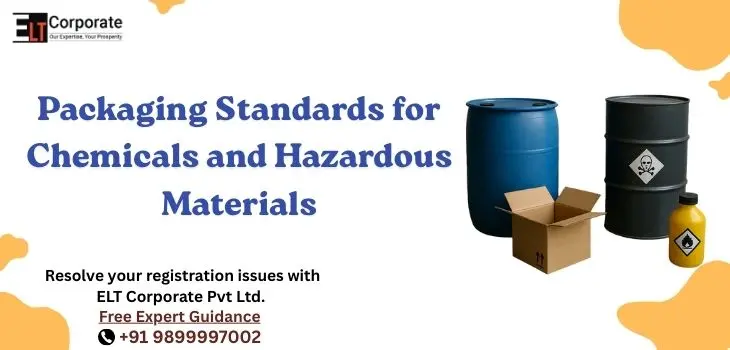In India’s regulated industrial ecosystem, compliance with chemicals and dangerous materials is not only about handling security – it extends to strict packaging standards. Proper packaging ensures that dangerous items are stored, transported and sold without endangering human health, environment, or trade safety. United Nations recommendations such as Packaging Regulations Bureau of Indian Standards (BIS), Legal Metrology Act, Environment Protection Act, and International Conferences are ruled by a mixture of rules for transporting dangerous goods.
For manufacturers, importers and distributors, meeting packaging standards is necessary to maintain market access, avoid punishment and ensure workplace safety.
Why Packaging Standards Matter
- Human safety – prevents leaks, contamination and accidents during storage, transit, or handling.
- Environmental protection – ensures that dangerous waste does not spread to soil, air or water sources.
- Regulatory coverage – apply to standard storage, labeling, transport and disposal of chemicals.
- Business Trust – compliance with packaging criteria creates reliability with regulators, customers and global supply chains.
Key Areas of Packaging Standards
- BIS & UN-Compliant Containers
- Use of certified drums, bottles, or Intermediate Bulk Containers (IBCs).
- Tested for strength, corrosion resistance, and leak-proof sealing.
- Use of certified drums, bottles, or Intermediate Bulk Containers (IBCs).
- Legal Metrology Labeling
- Mandatory declaration of net quantity, batch number, manufacturer/importer details, and MRP where applicable.
- Dual-language labelling (English + Hindi).
- Mandatory declaration of net quantity, batch number, manufacturer/importer details, and MRP where applicable.
- Hazard Communication Requirements
- Display of hazard symbols (flammable, toxic, corrosive, explosive, oxidizing, etc.).
- Safety Data Sheet (SDS) reference and handling instructions.
- Display of hazard symbols (flammable, toxic, corrosive, explosive, oxidizing, etc.).
- Transportation Regulations
- Packaging aligned with UN classification codes for dangerous goods.
- Marking of UN numbers and proper shipping names on containers.
- Packaging aligned with UN classification codes for dangerous goods.
- Special Provisions for E-commerce & Retail
- Even small packaged chemicals sold online (cleaning acids, solvents, lab chemicals) must meet packaging and labeling norms.
- Sellers bear responsibility for ensuring end-consumer safety.
- Even small packaged chemicals sold online (cleaning acids, solvents, lab chemicals) must meet packaging and labeling norms.
Penalties for Non-Compliance
- BIS and Packaging Rules – License cancellation of license, recalling products, and fined for unsafe packaging.
- Legal Metrology – penalty of up to ₹ 1 lakh, seizure of goods, and imprisonment for frequent violations.
- Environmental Law – EPA, liability for cleaning costs, environmental damage and prosecution under 1986.
- Combined impact-generation can prevent imports, cause accidents, and permanently damage the brand reputation.
Common Mistakes Businesses Make
- Using unused or non-functioned containers for export shipment.
- Missing danger label or incomplete net volume detail.
- To ignore the United Nations Transport Code during international shipping.
- Selling online chemicals without proper warning or instructions to handle.
- Failed to update the label after regulatory modifications.
How to Stay Compliant
- Use BIS-attested and unnatural packaging for dangerous items.
- Conduct regular packaging audit for strength, labelling and dangerous signs.
- Train staff on handling, sealing and storage practice.
- Verify weight equipment per year under legal metrology.
- Stay updated with information from BIS, DGFT and Ministry of Environment.
How ELT Corporate Helps Businesses
At ELT Corporate, we support manufacturers, importers, and distributors of chemicals with end-to-end compliance:
- BIS packaging standard certification and test support.
- Legal Metrology LMPC registration for packed imports.
- Label and packaging reviews to ensure dangerous compliance.
- Assistance with preparation of safety data sheet (SDS).
- Advice for audit, inspection and dispute resolution.
FAQs
Q1. Is BIS certification mandatory for chemical packaging?
Yes, BIS is applied to packaging materials such as drums, bottles and containers used for hazardous items to ensure standard security.
Q2. Do small chemical traders also need to follow packaging standards?
Yes, regardless of size, all businesses handling dangerous chemicals should follow BIS, legal metrology and labeling rules.
Conclusion
Packaging standard for chemicals and dangerous materials is important for ensuring standard security, protecting the environment and maintaining regulatory compliance. While BIS packaging ensures integrity, legal metrology makes the correct declarations compulsory, and dangerous communication rules provide user protection. Together, these framework protects stakeholders and strengthening professional reliability.
Need help with chemical packaging and compliance? Contact ELT Corporate today for expert support.







